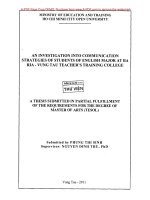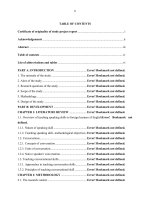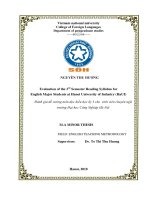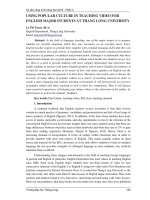Principles of designing British literature material for English major students at Ba Ria Vung Tau University
Bạn đang xem bản rút gọn của tài liệu. Xem và tải ngay bản đầy đủ của tài liệu tại đây (320.66 KB, 4 trang )
VIETNAM NATIONAL UNIVERSITY, HA HOI
UNIVERSITY OF LANGUAGES AND INTERNATIONAL STUDIES
FACULTY OF POST- GRADUATE STUDIES
----- ----BÙI THU HƯƠNG
PRINCIPLES OF DESIGNING BRITISH LITERATURE
MATERIAL FOR ENGLISH MAJOR STUDENTS AT BA RIA
VUNG TAU UNIVERSITY
(CÁC NGUYÊN TẮC THIẾT KẾ TƯ LIỆU VĂN HỌC ANH CHO SINH VIÊN
CHUYÊN TIẾNG ANH TẠI TRƯỜNG ĐẠI HỌC BÀ RỊA VŨNG TÀU)
MA. MINOR THESIS
Field: English Teaching Methodology
Code: 60 14 10
Submitted as partial requirements for the Master’s Degree in English Language Education
Hanoi, 2011
VIETNAM NATIONAL UNIVERSITY, HA HOI
UNIVERSITY OF LANGUAGES AND INTERNATIONAL STUDIES
FACULTY OF POST- GRADUATE STUDIES
----- ----BÙI THU HƯƠNG
PRINCIPLES OF DESIGNING BRITISH LITERATURE
MATERIAL FOR ENGLISH MAJOR STUDENTS AT BA RIA
VUNG TAU UNIVERSITY
(CÁC NGUYÊN TẮC THIẾT KẾ TƯ LIỆU VĂN HỌC ANH CHO SINH VIÊN
CHUYÊN TIẾNG ANH TẠI TRƯỜNG ĐẠI HỌC BÀ RỊA VŨNG TÀU)
MA. MINOR THESIS
Field: English Teaching Methodology
Code: 60 14 10
Submitted as partial requirements for the Master’s Degree in English Language Education
SUPERVISOR: DƯƠNG THỊ NỤ, PhD
Hanoi, 2011
vi
TABLE OF CONTENTS
CANDIDATE’S STATEMENT ............................................................................................................... i
ACKNOWLEDGEMENTS .....................................................................................................................ii
ABSTRACT ............................................................................................................................................iii
LIST OF ABBREVIATIONS ................................................................................................................. iv
LIST OF FIGURES, TABLES AND CHARTS ...................................................................................... v
TABLES OF CONTENTS...................................................................................................................... vi
PART A: INTRODUCTION ................................................................................................... 1
1.Rationale .................................................................................................................................. 1
2.Aims of the study ..................................................................................................................... 2
3.Method of research .................................................................................................................. 2
4.Scope of the study .................................................................................................................... 3
5.Design of the study .................................................................................................................. 3
PART B: DEVELOPMENT .................................................................................................... 5
CHAPTER I: LITERATURE REVIEW ................................................................................ 5
1.1.Material Design .................................................................................................................. 5
1.1.1. An overview of materials........................................................................................... 5
1.1.2. Categories of materials .............................................................................................. 5
1.1.2.1 Published materials .......................................................................................... 5
1.1.2.2. Authentic materials .......................................................................................... 5
1.1.2.3. Specially-prepared materials .......................................................................... 6
1.1.3. Characteristics of good materials .............................................................................. 6
1.1.4. The process of materials designing............................................................................ 7
1.1.5. Principles for designing materials ............................................................................ 8
1.1.6. Designing materials for British literature ................................................................ 10
1.1.6.1. The concept of literature................................................................................ 10
1.1.6.2. Models of teaching literature in ESL classroom ........................................... 11
1.1.6.3. Criteria for the literary text selection ........................................................... 12
1.2. Need analysis .................................................................................................................... 14
1.2.1. The concept of language needs ................................................................................ 14
1.2.2. Purposes of needs analysis in language teaching .................................................... 15
1.3. Summary of chapter 1 ..................................................................................................... 15
vii
CHAPTER II: NEEDS ANALYSIS AT BA RIA VUNG TAU UNIVERSITY ................ 16
2.1. Situational analysis .......................................................................................................... 16
2.1.1. Training Institution ................................................................................................. 16
2.1.2. Teaching staff .......................................................................................................... 16
2.1.3. Facilities ................................................................................................................... 16
2.1.4. The current syllabus and materials in use ................................................................ 17
2.1.4.1. Syllabus for British Literature ....................................................................... 17
2.1.4.2. Materials for British Literature ..................................................................... 17
2.1.5. Students.................................................................................................................... 18
2.2. The analysis of participants’ opinions ........................................................................... 19
2.2.1. Subjects of the study ................................................................................................ 19
a. The student population ........................................................................................... 19
b. The teacher population ........................................................................................... 19
2.2.2. Procedures ............................................................................................................... 19
2.2.3. Data analysis, findings and discussions ................................................................... 20
2.3. Summary of chapter 2 ........................................................................................................ 33
CHAPTER III: SOME PRINCIPLES OF DESIGNING BRITISH LITERATURE
MATERIALS FOR ENGLISH MAJOR STUDENTS AT BVU ........................................ 35
3.1. The compatibility with the syllabus .................................................................................. 35
3.2. The learners’ interests ........................................................................................................ 35
3.3. Paying attention to students’ linguistic proficiency and literary background ................... 36
3.4. Counting culture and other mother tongue-related elements in students’ first language .. 37
3.5. Selecting the literary texts.................................................................................................. 38
3.6. Taking notice of the teaching duration .............................................................................. 38
3.7. Taking teachers’ and students’ difficulties into account ................................................... 39
3.8. Samples of the British materials for students at BVU ....................................................... 41
PART C: CONCLUSION ...................................................................................................... 43
1. Recapitulation ....................................................................................................................... 43
2. Limitation of the study and suggestions for further research ............................................... 43
REFERENCE
APPENDICES









